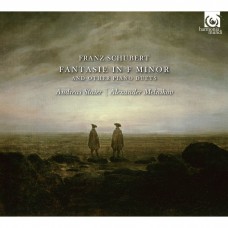|
In Upper Austria, I find my compositions everywhere, especially in the monasteries of Sankt Florian and Kremsmünster,
where with the help of a decent pianist I performed my four-hand variations and marches with great success.' So wrote Franz
Schubert in 1825, evoking the popular nineteenth-century genre that publishers were always pestering him to write. But the
Viennese composer went much further than the traditional German dances and sets of variations, as is shown by the
overwhelming Fantasie in F minor, one of the tragic masterpieces of his last year.
Franz Schubert
Fantasie op.103, D.940 F minor / fa mineur / f-Moll
1 I. Allegro molto moderato 4'56
2 II. Largo 2'22
3 III. Allegro vivace - Con delicatezza 6'23
4 IV. Finale. Tempo primo 5'43
5 4 Ländler, D.814 3'16
6 Marche Caracteristique, D.886 no. 1 C major / Ut majeur / C-DurI. Allegro Vivace 6'18
Variations on an Original Theme op.35, D.813A flat major / La bemol majeur / As-Dur
7 I. Thema. Allegretto 1'29
8 II. Variation I 1'31
9 III. Variation II 1'27
10 IV. Variation III. Un poco piu lento 1'59
11 V. Variation IV. Tempo I 1'31
12 VI. Variation V 2'03
13 VII. Variation VI. Maestoso 1'49
14 VIII. Variation VII. Più lento 3'27
15 IX. Variation VIII. Finale. Allegro moderato 4'22
16 Grande Marche op.40 no. 3, D.819B minor / re mineur / d-MollAllegretto 7'24
17 Polonaise op.61 no. 1, D.824 D minor / re mineur / d-Moll 4'22
18 Rondo op.107, D.951 A major / La majeur / A-DurAllegretto quasi andantino 12'30 |
|





